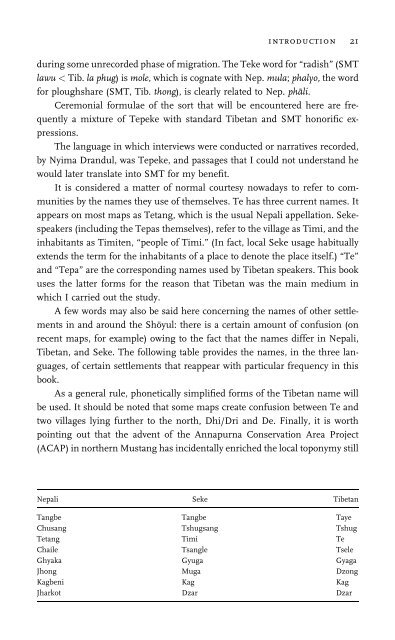Navel of the Demoness : Tibetan Buddhism and Civil Religion in ...
Navel of the Demoness : Tibetan Buddhism and Civil Religion in ...
Navel of the Demoness : Tibetan Buddhism and Civil Religion in ...
You also want an ePaper? Increase the reach of your titles
YUMPU automatically turns print PDFs into web optimized ePapers that Google loves.
<strong>in</strong>troduction 5<br />
What was especially <strong>in</strong>terest<strong>in</strong>g, however, was that it sounded archaic. These<br />
are siren voices, <strong>and</strong> anthropologists do not listen to <strong>the</strong>m.<br />
I returned to Nepal as soon as I had completed my doctorate, with <strong>the</strong> aim<br />
<strong>of</strong> f<strong>in</strong>d<strong>in</strong>g out more about this exotic, archaic village. Nyima met me on <strong>the</strong> day<br />
I arrived. I hardly recognised him. He was stout <strong>and</strong> well-dressed <strong>and</strong> he had a<br />
gold tooth. He had left his job <strong>in</strong> <strong>the</strong> sweatshop <strong>and</strong> entered <strong>the</strong> lucrative goldsmuggl<strong>in</strong>g<br />
bus<strong>in</strong>ess, which was <strong>the</strong>n at its height. I could not hope to employ<br />
him as an assistant at a competitive salary, but he agreed to help me whenever<br />
he was <strong>in</strong> Nepal—which, as it turned out, was frequently—on <strong>the</strong> condition<br />
that I did not pay him. He preferred, he said, to work out <strong>of</strong> <strong>in</strong>terest <strong>and</strong><br />
friendship ra<strong>the</strong>r than to be an unreliable employee.<br />
Lengthy periods <strong>of</strong> fieldwork <strong>in</strong> Te were out <strong>of</strong> <strong>the</strong> question because Upper<br />
Mustang, where <strong>the</strong> village is located, was still prohibited to foreigners.<br />
A h<strong>and</strong>ful <strong>of</strong> European scholars had visited Mustang <strong>in</strong> <strong>the</strong> past, but <strong>the</strong>ir <strong>in</strong>terest<br />
had been directed to <strong>the</strong> nor<strong>the</strong>rn, <strong>Tibetan</strong>-speak<strong>in</strong>g area, which had <strong>the</strong><br />
special attraction <strong>of</strong> boast<strong>in</strong>g a walled city <strong>and</strong> a k<strong>in</strong>g. Perhaps <strong>the</strong> only author<br />
to have said anyth<strong>in</strong>g <strong>of</strong> <strong>in</strong>terest about Te <strong>and</strong> its neighbours was Christoph<br />
von Fürer-Haimendorf, who had described <strong>the</strong> people as ‘‘Ur-Thakalis.’’ The<br />
Thakalis are an ethnic group who live primarily <strong>in</strong> south Mustang, below <strong>the</strong><br />
<strong>Tibetan</strong>-speak<strong>in</strong>g area, <strong>and</strong> <strong>the</strong> language spoken <strong>in</strong> Te is a variety <strong>of</strong> Thakali.<br />
The Thakalis have attracted <strong>the</strong> attention <strong>of</strong> an even more researchers than<br />
have <strong>the</strong> Sherpas. It was known that <strong>the</strong>y had gone through successive phases<br />
<strong>of</strong> acculturation by <strong>the</strong> <strong>Tibetan</strong> north <strong>and</strong> <strong>the</strong> Indo-Aryan south. The Tepas (<strong>the</strong><br />
people <strong>of</strong> Te), as ‘‘Ur-Thakalis,’’ might <strong>of</strong>fer a clue to an earlier phase <strong>of</strong> civilisation<br />
<strong>in</strong> Mustang (Fürer-Haimendorf 1966: 157; 1975: 132–203).<br />
The idea was not completely fantastic. I knew that animal sacrifices to<br />
territorial gods had been common practice <strong>in</strong> <strong>the</strong> <strong>Tibetan</strong>-speak<strong>in</strong>g area with<strong>in</strong><br />
liv<strong>in</strong>g memory, <strong>and</strong> that all <strong>the</strong> villages had ab<strong>and</strong>oned such rites at <strong>the</strong> <strong>in</strong>stigation<br />
<strong>of</strong> one or ano<strong>the</strong>r Buddhist or Bonpo missionary from Tibet. The<br />
custom <strong>of</strong> blood-<strong>of</strong>fer<strong>in</strong>gs still persisted <strong>in</strong> Te. (Much later I was to discover<br />
that Te was not <strong>in</strong> fact alone <strong>in</strong> this regard—at least two o<strong>the</strong>r villages <strong>in</strong> <strong>the</strong><br />
north still <strong>of</strong>fer animals to <strong>the</strong>ir gods.) The survival <strong>of</strong> <strong>the</strong> tradition was likely to<br />
be an <strong>in</strong>dicator <strong>of</strong> <strong>the</strong> endurance <strong>of</strong> o<strong>the</strong>r aspects <strong>of</strong> pre-Buddhist religion, <strong>and</strong><br />
<strong>the</strong> probability <strong>of</strong> this was <strong>in</strong>creased by <strong>the</strong> evident conservatism <strong>of</strong> <strong>the</strong> culture.<br />
Contrary to <strong>the</strong> case <strong>of</strong> o<strong>the</strong>r villages, <strong>the</strong> headmen <strong>of</strong> Te were endowed with<br />
real authority to ma<strong>in</strong>ta<strong>in</strong> both secular <strong>and</strong> religious traditions <strong>and</strong> to punish<br />
even m<strong>in</strong>or violations <strong>of</strong> customary law.<br />
Fieldwork at this time, I have said, was necessarily an exiguous aspect<br />
<strong>of</strong> my research, <strong>and</strong> most <strong>of</strong> <strong>the</strong> <strong>in</strong>formation was ga<strong>the</strong>red by Nyima, who<br />
paid visits to <strong>the</strong> village with a tape recorder <strong>and</strong> a list <strong>of</strong> questions, or by


